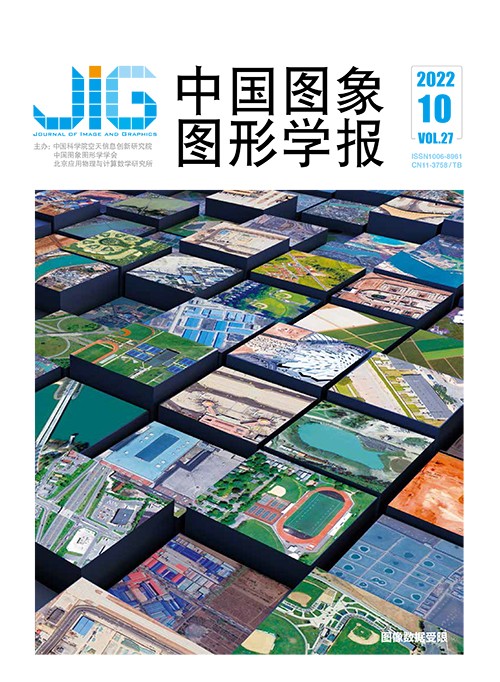
多监督损失函数光滑化图像超分辨率重建
摘 要
目的 将低分辨率(low-resolution,LR)图像映射到高分辨率(high-resolution,HR)图像是典型的不适定恢复问题,即输出的HR图像和输入的LR图像之间的映射是多对一的,这意味着仅通过增加网络深度来确定HR图像与LR图像之间的特定映射关系是非常困难的。针对该问题,本文提出一种基于多监督光滑化损失函数的图像超分辨率方法。方法 该方法主体由LR图像上采样通道和HR图像下采样通道两部分组成。各通道分为两个阶段,每个阶段均包括浅层特征提取模块、基于迭代采样错误反馈机制的采样模块、全局特征融合模块和图像重建模块。将LR图像上采样通道第1阶段结果与HR图像下采样通道第1阶段结果对比,然后将HR原图像和HR图像下采样通道第2阶段结果作为约束构成多监督,使映射函数空间尽可能精确,并将多监督损失函数光滑化保证梯度在全局范围内传递。结果 在基准测试集Set5、Set14、BSD100(Berkeley segmentation dataset)、Urban100(urban scenes dataset)、Manga109(109 manga volumes dataset)数据集上进行测试,并与Bicubic、SRCNN (super-resolution convolutional neural network)、FSRCNN (fast super-resolution convolutional neural network)、LapSRN (Laplacian pyramid super-resolution network)、VDSR (very deep super-resolution convolutional networks)、DBPN (deep back-projection networks for super-resolution)和DRN (dual regression networks)等方法的实验结果进行对比。当放大因子为4时,本文算法的峰值信噪比分别为32.29 dB、28.85 dB、27.61 dB、26.16 dB和30.87 dB;在重建图像的可视化分析方面,本文算法相较于对比算法具有更加丰富的纹理和清晰的轮廓。结论 实验结果表明,基于多监督光滑化损失函数方法的图像重建结果与其他超分辨率主流算法相比,在重建图像质量和高频细节处理方面均有所提高。
关键词
Multi-supervision loss function based smoothed super-resolution image reconstruction
Meng Zhiqing, Zhang Jing, Qiu Jianshu(School of Management, Zhejiang University of Technology, Hangzhou 310023, China) Abstract
Objective The issue of images interpretation can be used in human cancer diagnosis contexts. It can help law enforcement officers to forensics via license plate images as well. Single super-resolution image process restores the high-resolution image based on a low-resolution image. It is the key to mapping reconstruction to clarify the relationship between the low-resolution image and the high-resolution image. Emerging neural networks have developed super-resolution image contexts. To improve the clarity of reconstructed images, theses novel networks are used to learn information feature between low-resolution images and high-resolution images. It is challenged that the mapping is many-to-one between the output high-resolution image and the input low-resolution image, which tends to determine the high-resolution image via more network depth only. The specific mapping relationship is difficult to be identified between low-resolution images. We facilitate a reconstructed super-resolution image method based on multi-supervised smoothing loss function, this method can clarify the possible mapping space between the low-resolution image and the high-resolution image in terms of the added constraints to the objective function, and improves the quality of the reconstructed image.Method Our method is composed of two channels like low-resolution (LR) image up-sampling and high-resolution (HR) image down-sampling. Each channel is divided into two stages, and each stage includes 4 modules in the context of a shallow feature extraction, an iterative sampling error feedback mechanism based sampling, a global feature fusion, and an image reconstruction, respectively. Our analysis compares the results of the first stage of the LR image upsampling channel to the results of the first stage of the HR image downsampling channel. To map the function space accurately, the HR original image and the second stage result of the HR image downsampling channel are as the constraints to form multi-supervision, and the smoothed multi-supervised loss function ensures that the gradient is transmitted in the global scope, the channel attention module is added to the method in order to reduce the computational complexity of the network and get more effective features. The channel attention module can extract useful features and suppress invalid features to speed up network convergence. In order to improve the network ability to reconstruct image detail information, we introduce a global feature fusion module, which improves the degree of information fusion in the network, and utilizes shallow information and detailed texture effectively.Result We use the DIV2K (diverse 2k resolution high quality images) dataset as the training dataset. The DIV2K dataset is organized by 800 training images, 100 verification images and 100 test images. To verify the algorithm performance, we carry out quantitative and qualitative analyses both. The quantitative tests are performed on benchmark test sets, such as Set5, Set14, Berkeley segmentation dataset (BSD100), urban scenes dataset (Urban100), and 109 manga volumes dataset (Manga109). The results are compared to Bicubic, super-resolution convolutional neural network (SRCNN), fast super-resolution convolutional neural network (FSRCNN), Laplacian pyramid super-resolution network (LapSRN), very deep super-resolution convolutional networks (VDSR), deep back-projection networks for super-resolution (DBPN), and dual regression networks (DRN), our peak signal-to-noise ratio of the algorithm is 32.29 dB, 28.85 dB, 27.61 dB, 26.16 dB and 30.87 dB, respectively when the magnification factor is 4; the reconstructed image of this algorithm has richer texture in terms of the qualitative analysis and the reconstructed image is closer to the real image with a clear outline.Conclusion Our multi-supervision smoothing loss function is used as the objective function, and the objective function mapping space is clear. In addition, the network calculation complexity is reduced through adding the channel attention module and the global feature fusion module. The network convergence speed is accelerated, and the shallow features are fully utilized. Our experimental results show that the multi-supervised smoothing loss function based image reconstruction results have improved the quality of the reconstructed image and the processing of high-frequency detail in comparison with some typical super-resolution algorithms.
Keywords
super-resolution reconstruction iterative sampling multi-supervision mapping space smoothing loss function
|



 中国图象图形学报 │ 京ICP备05080539号-4 │ 本系统由
中国图象图形学报 │ 京ICP备05080539号-4 │ 本系统由